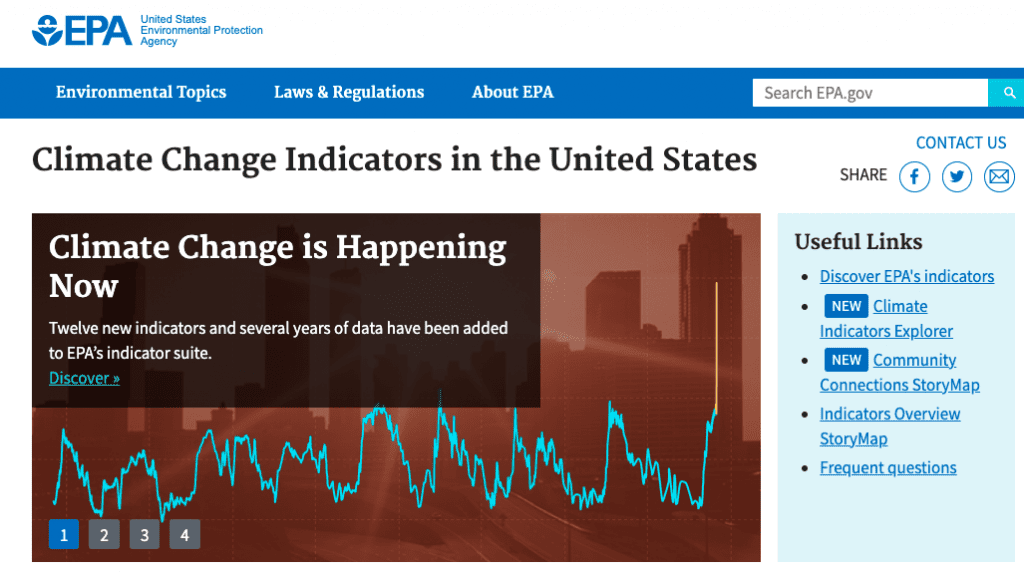It’s obvious to say at this point that climate change is caused by humans and the greenhouse gas emissions we produce. Well, for the United States Environmental Protection Agency (EPA), it kind of wasn’t.
For the first time ever, the agency publicly and officially acknowledged that human activities from fossil fuel extractions to agriculture are behind the growing greenhouse gas emissions. This was part of a climate report that was due in 2017 but was delayed by the Trump White House ever since.

The Climate Change Indicators report describes the extent to which glaciers are shrinking, sea levels are rising and flooding is increasing. The impacts are being felt by Americans “with increasing regularity”, it plainly states. Under Trump’s time in office, the report wasn’t updated, as it had been under former President Obama.
But even during Obama’s time, the EPA had never attributed global warming to human activities directly, a press officer for the agency told the BBC. That’s why this is such a big deal and represents a shift for the US – in line with more ambitious climate policies already announced by President Biden earlier this year. Simply put, it’s officially acknowledging what everyone — including EPA researchers — already knew.
EPA Administrator Michael Regan said in a statement that tackling climate change “isn’t optional” at the EPA and that the agency will move “with a sense of urgency,” making clear to the entire country the dangers of the rising temperatures in the United States.
“We want to reach people in every corner of this country because there is no small town, big city or rural community that’s unaffected by the climate crisis,” Regan said in a statement. “Americans are seeing and feeling the impacts up close with increasing regularity.”
An updated report
For its report, the EPA used a set of 54 separate indicators which, taken together, paint a grim picture of the effects of climate change in the US. It covers everything from Lyme disease (which is becoming more prevalent in some states where deer ticks can survive) to the more severe drought in the Southwest that threatens water availability.
The agency found that heat waves are happening three times more often in the US than they did in the 1960s, averaging six times a year. As a consequence, people are using more their air conditioners to stay cool in summer, which has doubled the energy use in summer over the past half-century, increasing emissions and triggering a vicious cycle.
Permafrost has also started to melt since 1978 at almost every location measured in Alaska, the report showed. The most significant temperature increases were registered in the northern parts of the state. EPA also found that coastal flooding is happening more often at all the 33 locations studied in the Pacific, Atlantic and Gulf coasts.
Kristina Dahl, a senior climate scientist at the Union of Concerned Scientists, told The Washington Post that the report collects data published by the Centers for Disease Control and Prevention and the National Oceanic and Atmospheric Administration. “It’s a really important clearinghouse of this kind of information,” she added.
Announcing the new report, the EPA said the data shows how the US has entered unprecedented territory, in which climate effects are more visible, changing faster and becoming more extreme. The indicators present “multiple lines of evidence that climate change is occurring now and here in the US,” the agency said in a statement.
The climate gap
The newly published data illustrates the gap between the current administration and Trump’s when it comes to climate policy. President Biden has made reducing greenhouse gas emissions one of his top priorities, arguing that a shift from fossil fuels to renewable energy sources would generate new and well-paid jobs and would help the country on multipple fronts.
While Trump questioned the idea that fossil fuels were warming the planet, Biden has already introduced a set of policies for further climate action. This includes a new climate pledge (also known as NDC), promising to reduce the country’s emissions by 50% to 52%. This meant doubling the previous pledge made by Obama in 2015.
In March, the Biden administration had already relaunched a first version of the EPA’s website on climate change, which had gone dark under Trump. In 2017, the Trump administration asked to remove all climate change reference from government websites, including the EPA, the Energy Department and the State Department.
A recent report by the Environmental Data and Governance Initiative (EDGI) showed that the use of the term “climate change” fell by 40% across federal environmental agency websites during Trump’s term in office from 2017 to 2021. The report also showed that access to EPA’s website dropped 20% during that time.


